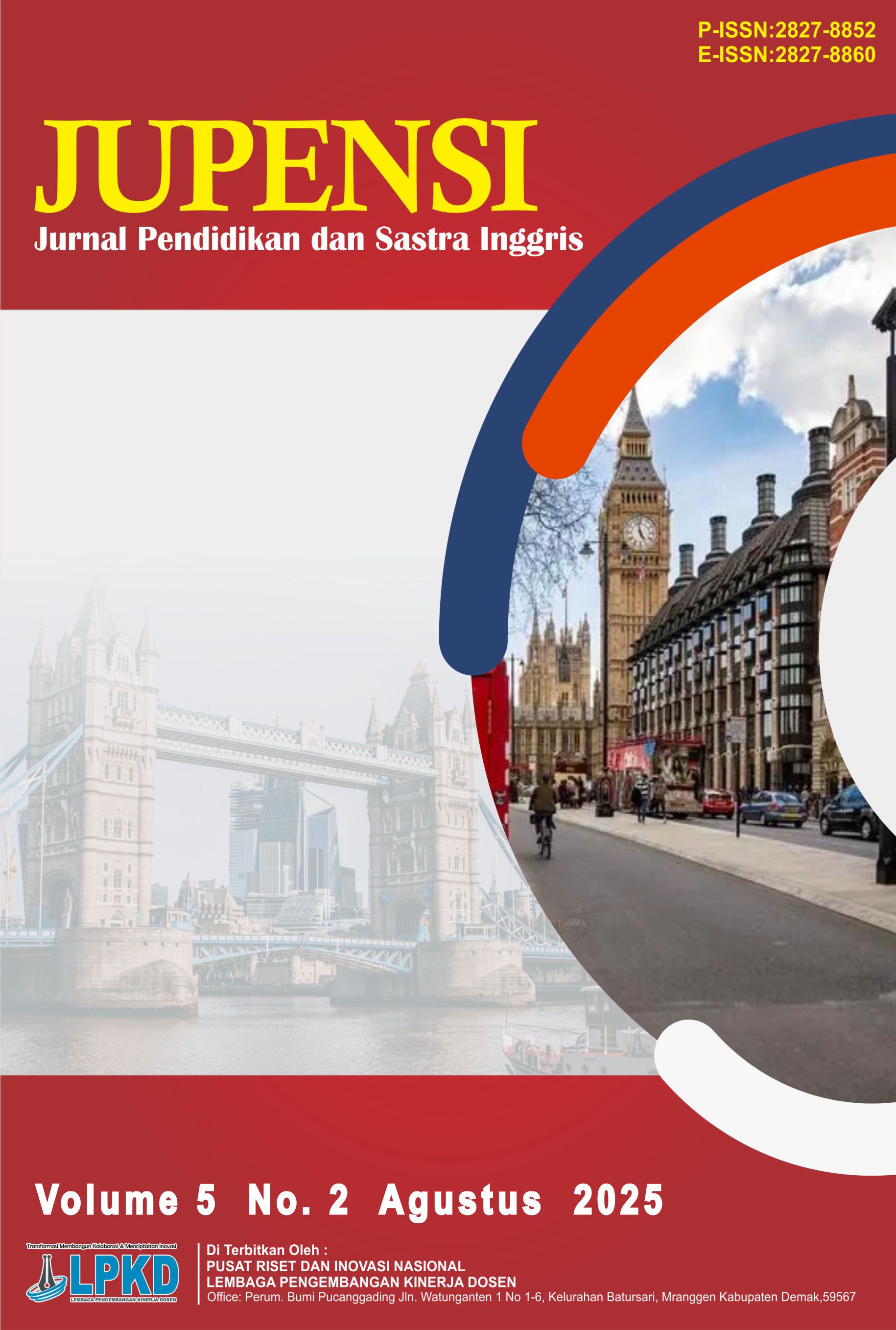The Effectiveness of Experiential Learning to Promote Speaking Skills of the Eleventh Grade Students in SMAN 2 Palangka Raya
DOI:
https://doi.org/10.55606/jupensi.v5i2.5720Keywords:
Effectiveness, Experiential Learning Method, Language Teaching Methods, Speaking Skill, StudentsAbstract
This study is aimed to measure the effect of experiential learning method to the speaking skills of the eleventh grade students of SMAN 2 Palangka Raya. In this study, the researcher used quasi-experimental design, where the researcher used nonrandomized control group pre-test, post-test design with a kind of treatment. In this study the researcher was helped by the English teacher of SMAN 2 Palangka Raya as the second tester for pre-test and post-test. In this experiment, the researcher taught the students directly with the same material. Therefore, the use of experiential learning method was applied on experiment group only, and for the control group the researcher applied conventional method. Meanwhile, the control group was not given the treatment. To examine the hypothesis, the researcher used t-test formula. In addition, the researcher used SPSS V 25 program to compare the data. The result of t test using manual calculation showed that the calculated value of tobserved was greater than the value of ttable at 5% significance level or 2.000 < 2.0312 < 2.660 and lower at 1%. the value of Tobserved was greater than the value of Ttable at 5% but lower at 1% significance level or 2.000 < 2.0312 < 2.660. The result of t-test using SPSS V 25 calculation found the calculated value (tobserved) Tobserved was greater than Ttable at 5% but lower at 1% significance level or 2.000 < 2.059 < 2.660. This indicated that the alternative hypothesis stating that there is significant effect of using experiential learning method toward students’ speaking score at eleventh grade students in SMAN 2 Palangka Raya was accepted and Ho stating that there is no significant effect of using experiential learning method toward students’ speaking score at eleventh grade students in SMAN 2 Palangka Raya was rejected. It meant that Experiential learning give significant effect to the students’ score.
The result of t test using manual calculation showed that the calculated value of tobserved was greater than the value of ttable at 5% significance level or 2.000 < 2.0312 < 2.660 and lower at 1%. the value of Tobserved was greater than the value of Ttable at 5% but lower at 1% significance level or 2.000 < 2.0312 < 2.660. The result of t-test using SPSS V 25 calculation found the calculated value (tobserved) Tobserved was greater than Ttable at 5% but lower at 1% significance level or 2.000 < 2.059 < 2.660. This indicated that the alternative hypothesis stating that there is significant effect of using experiential learning method toward students’ speaking score at eleventh grade students in SMAN 2 Palangka Raya was accepted and Ho stating that there is no significant effect of using experiential learning method toward students’ speaking score at eleventh grade students in SMAN 2 Palangka Raya was rejected. It meant that Experiential learning give significant effect to the students’ score
Downloads
References
Ary, D., Jacobs, L. C., & Razavieh, A. (2010). Introduction to research in education. CBS College Publishing.
Ary, D., Jacobs, L. C., Sorensen, C., & Razavieh, A. (2006). Introduction to research in education (8th ed.). Wadsworth, Cengage Learning.
Azwar, S. (2019). Reliabilitas dan validitas. Pustaka Pelajar.
Bailey, K. M. (2005). Practical English language teaching. McGraw-Hill.
Beard, C. (2023). The experiential learning toolkit: Blending practice with concepts. Kogan Page.
Brown, H. D. (2001). Teaching by principles: An interactive approach to language pedagogy. San Francisco State University.
Brown, H. D. (2014). Principles of language learning and teaching. San Francisco State University.
Chaer, A., & Agustina, L. (2004). Sosiolinguistik: Perkenalan awal. Asdi Mahasatya.
Clark, R. W., Threeton, M. D., & Ewing, J. C. (2010). The potential of experiential learning models and practices in career and technical education & career and technical teacher education. Journal of Career and Technical Education, 25(2), 46–62. https://doi.org/10.21061/jcte.v25i2.479
Cormany, D., & Feinstein, A. H. (2008). Implementation of effective experiential learning environment. Developments in Business Simulation and Experiential Learning, 35.
Creswell, J. W. (2018). Research design: Qualitative and quantitative approaches. SAGE Publications, Inc.
Diem, K. G. (2011). Learn by doing the 4-H way. University of Arkansas Cooperative Extension Service. http://www.uaex.edu
Djiwandono, S. (2011). Tes bahasa: Pegangan bagi pengajar bahasa. Indeks Press.
Fauziati, E. (2016). Teaching of English as a foreign language (TEFL). Muhammadiyah University Press.
Folse, K. (2006). The art of teaching speaking. The University of Michigan Press.
Gebhard, J. (2000). Teaching English as a foreign or second language. The University of Michigan Press.
Harmer, J. (2007). The practice of English language teaching. Longman.
Kolb, D. A. (2014). Experiential learning: Experience as the source of learning and development. Prentice Hall Inc.
Latief, M. A. (2010). Tanya jawab metode penelitian pembelajaran bahasa. UM Press.
Luoma, S. (2004). Assessing speaking. Cambridge University Press.
Millard, D. Z. (2011). Experiential learning in 4-H project experiences. University of Arkansas Cooperative Extension Service. http://www.uaex.edu
Muijs, D. (2004). Doing quantitative research in education. SAGE Publications Ltd. https://doi.org/10.4135/9781849209014
Nunan, D. (1995). Language teaching methodology: A textbook for teachers. National Centre for English Language Teaching and Research.
Nunan, D. (2003). Practical English language teaching. McGraw-Hill.
Reynolds, M., & Vince, R. (2007). The handbook of experiential learning & management education. Oxford University Press Inc. https://doi.org/10.1093/oso/9780199217632.001.0001
Richards, J. (2008). Teaching listening and speaking: From theory to practice. Cambridge University Press.
Silberman, M. (2007). The handbook of experiential learning. Pfeiffer.
Downloads
Published
How to Cite
Issue
Section
License
Copyright (c) 2025 Jurnal Pendidikan dan Sastra Inggris

This work is licensed under a Creative Commons Attribution-ShareAlike 4.0 International License.









